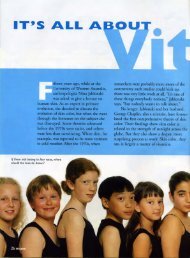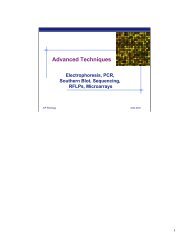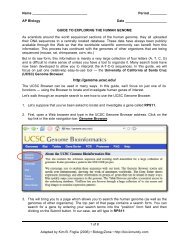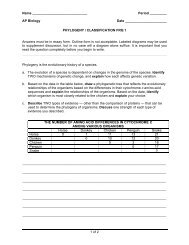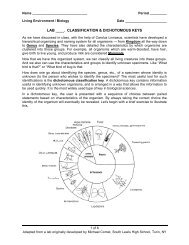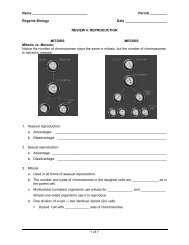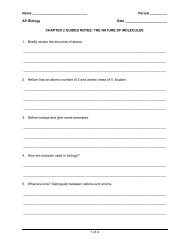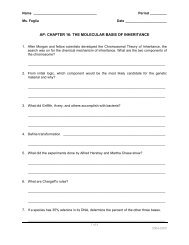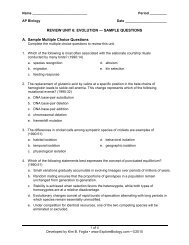Food Preferences of Slugs - Explore Biology
Food Preferences of Slugs - Explore Biology
Food Preferences of Slugs - Explore Biology
You also want an ePaper? Increase the reach of your titles
YUMPU automatically turns print PDFs into web optimized ePapers that Google loves.
• A “slugararium” (a slug-filled aquarium with a lid) is an excellent way to display the animals beforebeginning the lab. If possible, set the slugararium up several days before the lab activity to heightenstudent interest in the slugs.• The instructor’s preparation time might be as little as 15 minutes per class, if students are enlisted tocollect plants and slugs, to obtain empty margarine tubs (with lids), and to punch air holes in thelids. At least one hour <strong>of</strong> preparation time will be required, if the instructor assumes totalresponsibility for these tasks, including slicing fruits and vegetables into comparably thin sections,• <strong>Slugs</strong> can be kept in the refrigerator for several weeks prior to doing the lab and while accumulatingenough <strong>of</strong> them to supply each lab group. Air holes must be made in the lid <strong>of</strong> the container if noneexist. The bottom <strong>of</strong> the container should be partially covered with water (~1mm) to provide amoist environment. Scraps <strong>of</strong> lettuce make satisfactory food. Be sure to set the slugs out <strong>of</strong> therefrigerator at least 24 hours before beginning the experiment.• Plant material <strong>of</strong> various kinds can either be gathered from the yard and garden or purchased at thegrocery store. The possibilities for food plants to use in this exercise are virtually endless. Sinceslugs are <strong>of</strong>ten found in gardens and lawns, they might be provided with a selection <strong>of</strong> plant speciesfound in these areas. Leafy vegetables (lettuce, cabbage, spinach, etc.) can be cut easily into 20 mmx 20 mm squares, as can thinly sliced pieces <strong>of</strong> carrot, turnip, and onion scale leaves. Both grassesand broad-leaved weeds (dandelion, plantain, ground ivy, etc.) are also good choices for food,though some (such as grasses) may be rejected completely. A difficulty with grasses and someother plants is the small size or narrowness <strong>of</strong> the leaves. In such cases, students can cut two ormore pieces <strong>of</strong> leaf (rectangles or smaller squares) to equal a single standard-sized piece. But ifsmaller pieces are used, the instructor should point out that all other foods <strong>of</strong>fered to the slug(s) inthe same experiment should be cut up in the same way to insure that the shape and size <strong>of</strong> the foodplant samples are not uncontrolled variables.• <strong>Slugs</strong> will also feed on filter paper squares which have been soaked in plant extracts for a fewminutes. If students are investigating the basis <strong>of</strong> a food preference, this procedure would allowthem to eliminate texture as a variable. The filter paper may also be soaked in food coloring (e.g.,red versus green), or seasonings (e.g., a sugar solution, monosodium glutamate (MSG), mustard,vinegar). Of course, in any experiment involving filter paper squares, a piece soaked only in watershould be placed in the feeding chamber as a control, but the instructor may wish to let his studentscome up with that idea.• One potential problem is keeping track <strong>of</strong> which pieces are which since marks made on the samplemay be eaten by the slugs. The best approach is to indicate the positions <strong>of</strong> the different squares byusing appropriately labeled pieces <strong>of</strong> masking tape affixed to the outside <strong>of</strong> the feeding tub at thepoint nearest to the position <strong>of</strong> the corresponding square inside. Even this technique may fail if theslugs move the squares from their original positions. Though unlikely to occur, this may necessitatesmelling the remains in order to establish positive identification!©2000 CIBT <strong>Food</strong> <strong>Preferences</strong> <strong>of</strong> <strong>Slugs</strong> – Teachers Section Page 4



